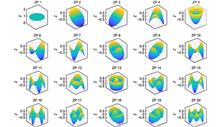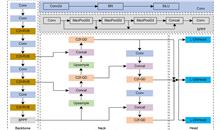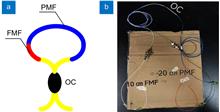 View fulltext
View fulltext
Zernike polynomials, due to their orthogonality and rotational invariance, are widely used in the characterization and optimization of optical surfaces. They can effectively reduce fitting errors and provide high-precision descriptions of complex surfaces with only a few coefficients, contributing to improved imaging quality and simplified performance analysis in optical systems. This paper provides an overview of freeform surface description methods, including both global and local approaches. It discusses the research progress on Zernike polynomials in surface characterization, both domestically and internationally, explores their practical applications in this field, and finally anticipates the future prospects of Zernike polynomials in surface characterization.
An improved YOLOv8 algorithm is proposed to address the problems of low detection accuracy and weak generalization ability in existing roadbed slope crack detection algorithms. Firstly, a reparameterization module is embedded in the backbone network to lighten the model while capturing crack details and global information, improving detection accuracy of the model. Secondly, the C2f-GD module is designed to achieve efficient fusion of model features and enhance the generalization ability of the model. Finally, the lightweight detection head L-GNHead is designed to improve the crack detection accuracy for different scales, while the SIoU loss function is used to accelerate model convergence. The experimental results on the self-constructed roadbed slope crack dataset show that the improved algorithm improves mAP50 and mAP50-95 by 3.3% and 2.5% respectively, reduces parameters and computational costs by 46.6% and 44.4% respectively, and improves FPS by 18 frames/s compared with the original algorithm. The generalization validation results on the dataset RDD2022 show that the improved algorithm not only achieves higher detection accuracy, but also faster detection speed.
This paper proposes a laser temperature sensor based on polarization maintaining fiber (PMF) and few-mode fiber (FMF), and conducted their experimental studies. A 20 cm polarization maintaining fiber was spliced with a 10 cm few-mode fiber and then combined with a 3 dB coupler to form a Sagnac loop, which served as the sensing probe. Light passing through the FMF excites higher-order modes. Due to the diameter mismatch between the FMF and PMF, the higher-order modes are coupled into the stress region of the PMF, exciting the cladding modes and thus improving temperature sensitivity. Experimental results show that after adding the FMF, the temperature sensitivity of the sensor increased from −0.51 nm/℃ to −0.91 nm/℃. This sensor has the advantages of high precision, easy fabrication, and intrinsic safety, making it highly promising for engineering structure safety monitoring applications.
A metamaterial-based optical solar reflector (OSR) consisting of a three-layer structure of aluminum-doped zinc oxide (AZO) metasurface, a MgF2 dielectric layer and an Ag metal reflector layer is investigated. In the thermal infrared, the AZO metasurface excites the surface equipartition excitation resonance to enhance the electromagnetic absorption, the stability of the MgF2 dielectric constant reduces the reflection caused by the absorption oscillations. In the visible light, the transparent properties of AZO and MgF2 provide the low loss for the solar radiation, and the Ag reflector layer effectively suppresses the transmission. Simulation results show that the optimized OSR has a low solar absorptivity of 17.6% in 0.3~2.5 µm and a high IR emissivity of 86.5% in 2.5~30 µm. In addition, polarization and angle of incidence have a small effect on its performance. The structure achieves good absorption in the infrared band and also has potential applications in infrared thermography, radiative cooling, and other fields.
In scanning PMP, it is essential to first match different positions of the object to the same point, and then extract phase information using phase-shifting algorithms. Both pixel-matching accuracy and phase-shifting algorithms influence measurement precision. To address this, a microscopic system is employed, leveraging its telecentric optical path characteristics to achieve equal conversion between object displacement and pixel displacement. By alternately capturing white-field and fringe images, precise pixel matching is realized through optical flow in the white-field images, followed by accurate pixel matching of the fringe images based on the object's uniform motion. A set of N fringe images, closely matching a full cycle based on the initial fringe period, is selected to compute the truncated phase distribution using an arbitrary step phase-shifting method. The optimal fringe period is then identified through a probability density function, leading to the accurate extraction of phase information and the completion of the object morphology measurement. Experimental results demonstrate that the proposed method significantly enhances measurement accuracy, with the phase-shifting algorithm applying to any N≥3 images, making it particularly suitable for 3D measurements of objects in industrial production lines, achieving an RMSE measurement accuracy of about 0.008 mm.
With the widespread application of low-altitude drones, real-time detection of such slow and small targets is crucial for maintaining public safety. Traditional cameras capture image frames with a fixed exposure time, which makes it challenging to adapt to changes in lighting conditions, resulting in the detection of blind spots in intense light and other scenes. Event cameras, as a new type of neuromorphic sensor, sense differences in external brightness changes pixel by pixel. They can still generate high-frequency sparse event data under complex lighting conditions. In response to the difficulty of adapting image-based detection methods to sparse and irregular data from event cameras, this paper models the two-dimensional object detection task as a semantic segmentation task in a three-dimensional spatiotemporal point cloud and proposes a drone object segmentation model based on dual-view fusion. Based on the event camera collecting accurate drone detection datasets, the experimental results show that the proposed method has the optimal detection performance while ensuring real-time performance, achieving stable detection of drone targets.
In view of the lack of spatial depth information in two-dimensional heat maps and the problems of complex calibration, high equipment cost, and limited use conditions in the existing multi-sensor schemes to establish the spatial temperature field model of the target object, this study proposes a spatial temperature field reconstruction scheme under a single thermal camera based on geometric constraints. Firstly, the temperature matrix collected by the thermal imager is remapped to the gray color space through the automatic threshold method, and the clear edge information of the target is obtained to filter out the irrelevant background. Then, the pose relationship of the target in the coordinate system of the thermal imager is directly calculated by the geometric constraints existing in the imaging process of the thermal imager and the imaging principle of the camera. Then, the 3D model of the target object is projected to the 2D heat map plane, and the texture mapping parameters of the 3D model are obtained. With the multi-view data acquisition of the target object by the thermal camera, the spatial temperature field reconstruction of the target object surface is completed. The experimental results show that, compared with the multi-sensor spatial temperature field reconstruction scheme, the average error of the single thermal imager scheme in this paper is only 4.3%, which can accurately and stably complete the spatial temperature field reconstruction of the target.
To address the challenges of complex backgrounds, small targets, and dense distributions in images, an improved method called DES-YOLO is proposed. By introducing the deformable attention module (DAM), the network can dynamically focus on key regions, improving object recognition and localization accuracy. The efficient intersection over union (EIoU) loss function is employed to reduce the impact of low-quality samples, enhancing the model's generalization ability and detection accuracy. A shallow feature map layer of 160 pixel×160 pixel is added to the network head to strengthen small target feature extraction. A stepwise training strategy is also adopted to further improve model performance. Experimental results show that the mAP@50 of the model increased by 1.4% on the remote sensing dataset and by 1.7% on the textile dataset, demonstrating the broad applicability and effectiveness of DES-YOLO.
To address issues of low detection accuracy and high false-positive and false-negative rates in solar cell defect detection, this paper proposes an optimized solar cell electroluminescent (EL) defect detection model based on the YOLOv8 deep learning framework. First, a self-calibrated illumination (SCI) method is applied to preprocess low-light images, enhancing effective feature information for solar cell defects. Then, a space-to-depth (SPD) attention module is introduced, replacing the second stride convolution layer in the backbone network. This substitution avoids information loss caused by stride convolution, expands the receptive field, and reduces computational load, preserving more feature information during extraction. Next, a spatial-BiFPN (S-BFPN) network is constructed to perform multi-scale feature fusion, stabilizing defect recognition rates by addressing the shape variability of solar cell defects. Lastly, the loss function is improved by adopting MPDIoU, which resolves the issue of ineffective penalties in the original CIoU loss function. The experimental results show that the improved YOLOv8 model achieved an mAP of 96.9%, a 2.2% increase compared to the original YOLOv8. The computational load was reduced by 0.2 GFlops, and the detection speed reached a maximum of 155 f/s, demonstrating high accuracy and real-time performance, making it more suitable for industrial deployment.














